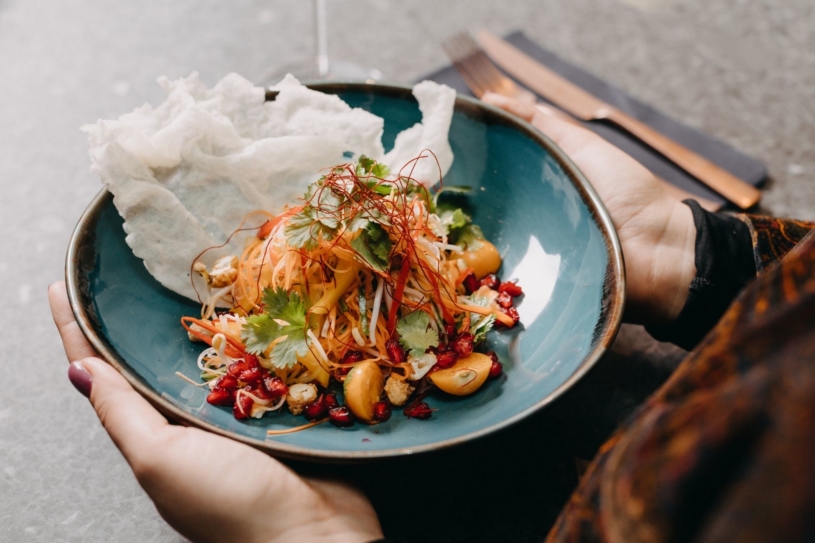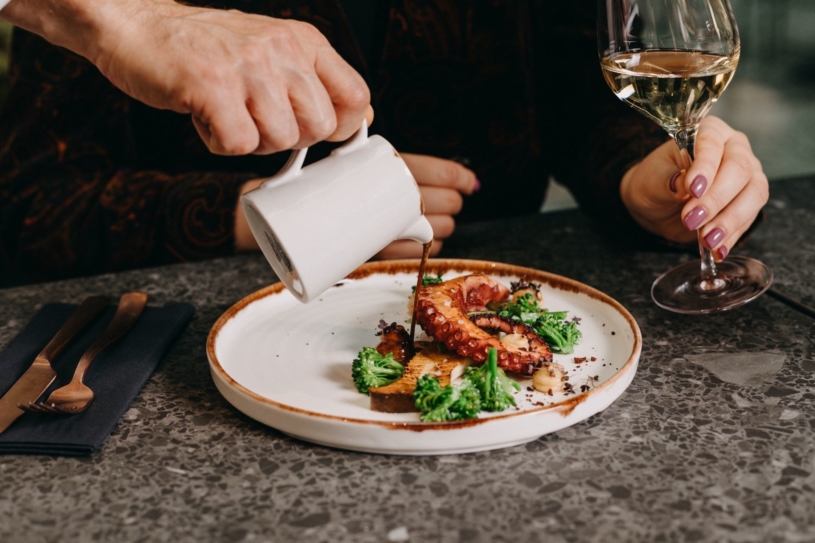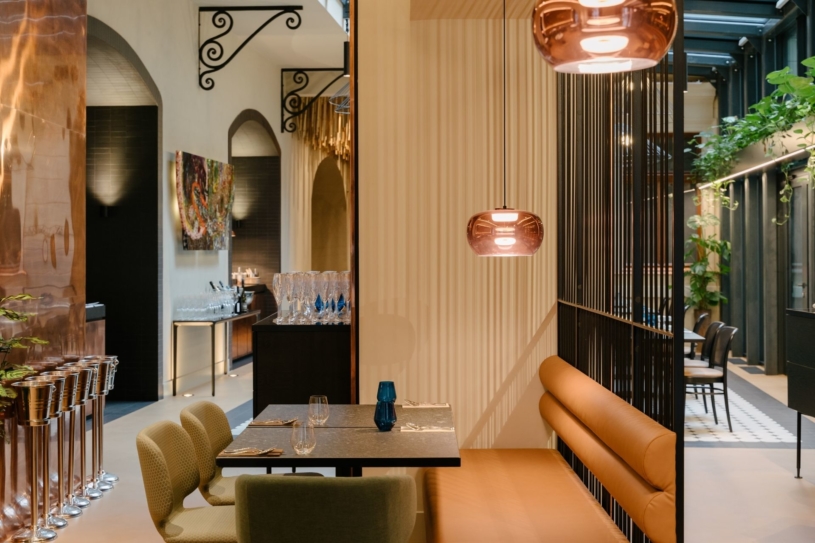
Chef Sensa Fine Food Bistro Zdeněk Křížek
Bistro Sensa, which has increased the concentration of interesting businesses in the vicinity of Prague’s Jindřiška Tower, represents a fresh gastronomic breeze. Chef Zdeněk Křížek and his colleague Jan Číhal have started to inflect the term modern gastronomy in a more progressive way. You can’t get asparagus here in winter, but you can taste freshwater fish from aquaponics.
In the space, which is functionally and visually divided into several parts, Zdeněk and Jan combine the best of informal dining with fine dining elements, innovative approaches and trends in the gastronomic field with traditional ones, and above all they try to put together a menu that reflects the requirements of guests, even those with food allergies. They draw on their many years of experience in first-class hotels and restaurants and successfully show what direction contemporary gastronomy could take.
Zdeněk Křížek worked, among others, in the Mandarin Oriental Hotel, thanks to which he also gained a lot of experience in cuisines in Japan, Malaysia, China and England. “I moved from Mandarin Oriental to head chef of the Orea Hotels & Resorts chain, where I first deepened the trend of modern gastronomy across the concepts within the chain. Over the years, we started to prepare another space where I could work as a chef,” he says.
Sturgeon from aquaponics
The idea took some time to mature, but it was clear to both Křížek and his colleague Číhal that they wanted to build the concept of the new restaurant primarily on the experience that Zdeněk had gained during his international work. “I said to myself that this area lacks a nice place with a private atmosphere where you can enjoy really good gastronomy from all over the world. And thanks to my long-term work in an international chain, I have a broad perspective on cooking. It would be such a shame to create a concept that sticks to pure Asian cuisine, modern Czech cuisine, French cuisine, or, on the contrary, it’s a melting pot of everything, but without authenticity.”
So how could one describe the approach taken at Sensa Bistro? “We present international cuisine with an Asian touch,” Jan Číhal sums it up succinctly. And the Asian touch is really evident on both the lunch menu and the evening menu. Zdeněk Křížek adds that he works well with Asian ingredients and knows how to combine them with local ingredients to create novel flavours that can be well paired with wine even without the prescribed pairing.
They really care about that too. “We wanted our wine offer to consist of the best of Bohemia and Moravia, in addition to a few iconic items, but also progressive and lesser-known wines from abroad, which we are trying to discover for our guests,” adds Číhal. The wine list, consisting of approximately sixty bottles, features mainly light, mineral, dry wines that can be paired with courses across the entire menu without much thought.
One of the pillars on which Sensa stands is the emphasis on raw materials. Of course, this may be a bit of a cliché nowadays, as you expect first-class and above all fresh ingredients in an establishment of this kind. Even so, they can be taken up a level, which is what Sensa Bistro has done.
“Last year I was approached by the guys from the aquaponic farm in Lážovice. Aquaponics combines fish farming with plant cultivation. This is still quite a rarity in our country, but I have been very close to the idea of going down this greener path for a long time, so I was intrigued by the idea of cooperation from the beginning. Moreover, the fish from the aquaponics in Lážovice are of perfect quality,” describes the chef.
The Lážovice farm operates on the principle of an aquaponic recirculation system. The water in which freshwater fish are kept is used to irrigate herbs and vegetables using a pump. The plants take the necessary nutrients and the residual water is returned to the fish tanks. It is a continuous cycle that is close to the processes in the wild, and saves land and space.
Currently, you can find Siberian sturgeon, African catfish, Nile tilapia, as well as various herbs, chilli and chard on your plate at Sensa bistro. “Carp was on the menu for Christmas, so we thought we’d try making carp chips. I came up with a slightly more sophisticated recipe and then there were three days when we sold practically only carp fries from the lunch menu,” Křížek adds with a laugh.
With tolerance for guests with intolerances
At the same time, the chefs wanted the menu at Sensa to be suitable for guests with intolerances and allergies, which is another aspect that makes them stand out on the domestic gastronomic scene. Increasingly, they perceived that people who cannot tolerate certain nutrients were often condemned to homogeneous menus and had to do research appropriate to the preparation for their thesis when choosing a place to go for a nice lunch or dinner.
“Unfortunately, even today I often encounter the fact that guests are divided according to how they can and cannot eat. That’s why I think a little differently about the recipes and try to develop and innovate them so that even a person with food allergies can have a full and interesting lunch here from Monday to Friday, not just a simple salad without the necessary nutrients.” explains Křížek.
Not only the lunch menu, but also the evening menu at the Sensa bistro impresses with its variety, and at first glance it is really obvious that the local chef has thought about the menu in order to adapt the individual courses to the specific requirements of some guests. “When someone comes in who needs to adapt their meal for health reasons, we are ready to advise and adjust the individual courses if necessary so that such a guest can really enjoy them. That’s what we’re here for, after all.” He says.
For a person who has been dealing with unpleasant situations when ordering food for a long time, this approach is a great relief. At the same time, Zdeněk Křížek proves that he is not just jumping on a trend, but that he thinks about what he prepares for his guests in a broader context. “Today we have all got used to the fact that nothing is a problem and we can have everything at any time of the year. But because of this, the lust disappeared, when a given raw material is not available and I can look forward to it. That’s why I try to work with a culinary calendar. Having asparagus in the middle of January is a complete atrocity,” he’s getting loose.
The ingredients that nature – both local and Asian – will offer in a certain season will also change the menu at Sensa bistro. Root vegetables, mushrooms, pears and plums are the most popular on the current menu. The above-mentioned combination of fresh flavours is perfectly presented by the gyoza dumplings, which are among the evening starters. It is complemented by orange ponzu sauce together with citrus yuzu mayonnaise, a combination that adds a lightness to the whole dish. Black truffles with Asian mushrooms and tuna shavings of katsuobushi create a pleasant contrast, while their umami flavour is not too overwhelming, so one can enjoy the interplay of all the sensations.
Among the main courses, the grilled octopus with creamy parsnip puree and port wine sauce stands out. The flavour and tenderness of the meat stands out on its own, and the specific texture of the octopus goes perfectly together with the delicate puree – every bite is a multilayered sensory experience. Lighter in flavour but still very complex is the sea bream with yellow mango curry sauce, accompanied by a crunchy Indonesian salad.
Similarly, the dessert menu will please all diners, whether they can eat anything or have to choose. For example, such an exotic mango lassi tastes fantastic even in a lactose-free version. An unearthly experience is the tiramisu, in which Zdeněk Křížek replaced cocoa with pistachios from Iran, creating an affair that is fluffy beyond belief, decadent and satisfying to such an extent that even after a multi-course dinner you will be sorry when the last remnants of sweet cream disappear from your plate – the only sad moment associated with a visit to this place.
More on CzechCrunch





